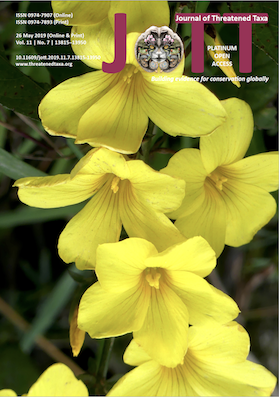First assessment of bird diversity in the UNESCO Sheka Forest Biosphere Reserve, southwestern Ethiopia: species richness, distribution and potential for avian conservation
Main Article Content
Abstract
The Sheka Zone in southwestern Ethiopia is covered by some of the largest remaining forests in the Eastern Afromontane biodiversity hotspot. Owing to the rich biodiversity and a high degree of endemism, it was declared as a biosphere reserve by UNESCO in 2012 and is considered a Key Biodiversity Area. Detailed knowledge on species diversity and distribution in the reserve is, however, severely limited. From February to April 2016, an assessment of the bird diversity and distribution in the reserve was made for the first time through point count transects, camera-trap recordings and opportunistic observations. In total, 244 bird species were identified, of which 19% was only found within the reserve’s designated protected zones. Our study indicates a remarkable bird species richness across the different habitats in Sheka Forest Biosphere Reserve and can be used as a baseline for future monitoring studies and conservation planning.
Article Details
Authors own the copyright to the articles published in JoTT. This is indicated explicitly in each publication. The authors grant permission to the publisher Wildlife Information Liaison Development (WILD) Society to publish the article in the Journal of Threatened Taxa. The authors recognize WILD as the original publisher, and to sell hard copies of the Journal and article to any buyer. JoTT is registered under the Creative Commons Attribution 4.0 International License (CC BY), which allows authors to retain copyright ownership. Under this license the authors allow anyone to download, cite, use the data, modify, reprint, copy and distribute provided the authors and source of publication are credited through appropriate citations (e.g., Son et al. (2016). Bats (Mammalia: Chiroptera) of the southeastern Truong Son Mountains, Quang Ngai Province, Vietnam. Journal of Threatened Taxa 8(7): 8953–8969. https://doi.org/10.11609/jott.2785.8.7.8953-8969). Users of the data do not require specific permission from the authors or the publisher.
References
Aerts, R., G. Berecha & O. Honnay (2015). Protecting coffee from intensification. Science 347: 139.
BirdLife International (2017). The World Database of Key Biodiversity Areas. Key Biodiversity Areas Partnership: BirdLife International, IUCN, Amphibian Survival Alliance, Conservation International, Critical Ecosystem Partnership Fund, Global Environment Facility, Global Wildlife Conservation, NatureServe, Royal Society for the Protection of Birds, World Wildlife Fund and Wildlife Conservation Society. Downloaded from http://www.keybiodiversityareas.org on 02 November 2017.
De Beenhouwer, M., R. Aerts & O. Honnay (2013). A global meta-analysis of the biodiversity and ecosystem service benefits of coffee and cacao agroforestry. Agriculture, Ecosystems & Environment 175: 1–7.
Dessie, G. & J. Kleman (2007). Pattern and magnitude of deforestation in the South Central Rift Valley Region of Ethiopia. Mountain Research and Development 27: 162–168.
Engelen, D., D. Lemessa, Ç.H. Şekercio Ğlu & K. Hylander (2017). Similar bird communities in homegardens at different distances from Afromontane forests. Bird Conservation International 27: 83–95.
FAO (2015). Global Forest Resources Assessment 2015. Food and Agriculture Organization of the United Nations, Rome, 244pp.
Friis, I. (1992). Forests and forest trees of northeast tropical Africa – their natural habitats and distribution patterns in Ethiopia, Djibouti, and Somalia. Kew Bulletin 15: 1–396.
Gole, T.W. & F. Getaneh (2011). Sheka Forest Biosphere Reserve Nomination Form. UNESCO-MAB National Committee, Federal Democratic Republic of Ethiopia, Addis Ababa, 157pp.
Hundera, K., R. Aerts, M. De Beenhouwer, K. Van Overtveld, K. Helsen, B. Muys & O. Honnay (2013). Both forest fragmentation and coffee cultivation negatively affect epiphytic orchid diversity in Ethiopian moist evergreen Afromontane forests. Biological Conservation 159: 285–291.
Mittermeier, R.A., W.R. Turner, F.W. Larsen, T.M. Brooks & C. Gascon (2011). Global biodiversity conservation: the critical role of hotspots, pp3–22. In: Zachos, F.E. & J.C. Habel (Eds.) Biodiversity Hotspots. Springer-Verlag, Heidelberg, Berlin, xvii+546pp.
Redman, N., T. Stevenson & J. Fanshawe (2011). Birds of the Horn of Africa: Ethiopia, Eritrea, Djibouti, Somalia and Socotra. Christopher Helm, Bloomsbury Publishing, London, 488pp.
Reusing, M. (2000). Change detection of natural high forests in Ethiopia using remote sensing and GIS techniques. International Archives of Photogrammetry and Remote Sensing 33: 1253–1258.
Rodrigues, P., G. Shumi, I. Dorresteijn, J. Schultner, J. Hanspach, K. Hylander, F. Senbeta & J. Fischer (2018). Coffee management and the conservation of forest bird diversity in southwestern Ethiopia. Biological Conservation 217: 131–139.
Tadesse, G., E. Zavaleta & C. Shennan (2014). Coffee landscapes as refugia for native woody biodiversity as forest loss continues in southwest Ethiopia. Biological Conservation 169: 384–391.
Woldegeorgis, G. & T. Wube (2012). A survey on birds of the Yayu forest in southwest Ethiopia. SINET: Ethiopian Journal of Science 35: 63–68.
Woldemariam, T. & M. Fetene (2007). Forests of Sheka: Ecological, social, legal and economic dimensions of recent land use/land cover changes, overview and synthesis, pp. 1–21. In: Fetene, M. (ed.) Forests of Sheka: Multidisciplinary Case Studies on Impacts of Land use/Land cover Changes. Melca-Mahiber, Addis Ababa, viii+231pp.

